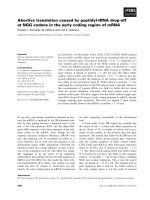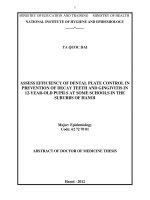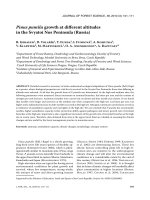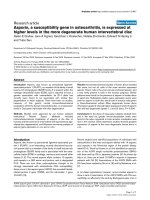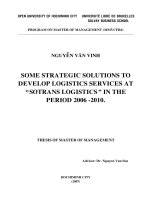DSpace at VNU: Squark Pair Production at Muon Colliders in the MSSM with CP Violation
Bạn đang xem bản rút gọn của tài liệu. Xem và tải ngay bản đầy đủ của tài liệu tại đây (2.23 MB, 8 trang )
Int J Theor Phys (2010) 49: 1457–1464
DOI 10.1007/s10773-010-0326-1
Squark Pair Production at Muon Colliders in the MSSM
with CP Violation
Nguyen Thi Thu Huong · Nguyen Chinh Cuong ·
Ha Huy Bang · Dao Thi Le Thuy
Published online: 31 March 2010
© Springer Science+Business Media, LLC 2010
Abstract We study the pair production of scalar quark in a muon collider within the MSSM
with CP violation. We show that including the CP phases can strongly affect the cross section
of the process: μ+ μ− → q˜i q¯˜j . This could have an important impact on the search for squarks
and the determination of the MSSM parameters at future colliders.
Keywords MSSM · CP violation · Muon collider
1 Introduction
The minimal supersymmetric standard model (MSSM) is one of the most promising extensions of the Standard Model. The MSSM predicts the existence of scalar partners to all
known quarks and leptons. Each fermion has two spin zero partners called sfermions fL and
fR , one for each chirality eigenstate: the mixing between fL and fR is proportional to the
corresponding fermion mass, and so negligible except for the third generation.
Only three terms in the supersymmetric Lagrangian can give rise to CP violating phases,
which cannot be rotated away: The superpotential contains a complex coefficient μ in the
term bilinear in the Higgs superfields. The soft supersymmetry breaking operators introduce
two further complex terms, the gaugino masses Mi , and the left- and right-handed squark
mixing term Aq . In the MSSM one has two types of scalar quarks (squarks), qL and qR ,
corresponding to the left and right helicity states of a quark. The mass matrix in the basis
(qL , qR ) is given by [1],
Mq2 =
m2qL
aq m q
aq m q
m2qR
= (R q )+
m2q1
0
N.T.T. Huong ( ) · H.H. Bang
Department of Physics, Vietnam National University, Hanoi, Vietnam
e-mail:
N.C. Cuong · D.T.L. Thuy
Department of Physics, Hanoi University of Education, Hanoi, Vietnam
0
(R q )
m2q2
(1)
1458
Int J Theor Phys (2010) 49: 1457–1464
with
q
2
m2qL = MQ
+ m2Z cos 2β(I3L − eq sin2 θw ) + m2q ,
(2)
2
m2qR = M{u,
+ eq m2Z cos 2β sin2 θw + m2q ,
D}
(3)
aq = Aq − μ{cot β, tan β},
(4)
q
for {up, down} type squarks, respectively. eq and I3L are the electric charge and the third
component of the weak isospin of the squark q, and mq is the mass of the partner quark.
MQ , Mu and MD are soft SUSY breaking masses, and Aq are trilinear couplings. According
to (1) Mq2 is diagonalized by a unitary matrix R q . The weak eigenstates qL and qR are thus
related to their mass eigenstates q1 and q2 by
q
q1
= Rq L
q2
qR
(5)
with complex parameters, we have
i
Rq =
e 2 φq cos θq
i
−e 2 φq sin θq
i
e− 2 φq sin θq
,
i
e− 2 φq cos θq
(6)
with θq is the squark mixing angle and φq = arg(Aq ). The mass eigenvalues are given by
m2q1,2 =
1
m2qL + m2qR ∓
2
(m2qL − m2qR )2 + 4aq2 m2q .
(7)
By convention, we choose q1 to be the lighter mass eigenstate. For the mixing angle θq we
require 0 θq π . We thus have
cos θq =
− aq m q
(m2qL − m2q1 )2 + aq2 m2q
,
sin θq =
m2qL − m2q1
(m2qL − m2q1 )2 + aq2 m2q
.
(8)
In particular, this model shows that the possibility to discover one of the scalar partners of
the top quark (t1 ) is higher than that of other scalar quarks and the top quark [1]. As well
known, CP violation arises naturally in the third generation Standard Model and can appear
only through the phase in the CKM-matrix. In the MSSM with complex parameters, the
additional complex couplings may lead to CP violation within one generation at one-loop
level [2, 3].
A muon collider can be circular and much smaller than e+ e− or hadron colliders of comparable effective energies. With its expected excellent energy and mass resolution a muon
collider offers extremely precise measurements. Moreover, it allows for resonant Higgs production; in particular it may be possible to study the properties of relatively heavy H 0 and
A0 which can hardly be done at any other collider. Information about ongoing work can be
found in [4–6].
In this paper we study the squark pair production in μ+ μ− collider within the MSSM
with complex parameters. The analytical formulae are derived and numerical results are
discussed.
Int J Theor Phys (2010) 49: 1457–1464
1459
2 Analytical Results
Our terminology and notation are as in [7, 8]. Squark pair production in μ+ μ− -annihilation
proceeds via the exchange of a photon, a Z boson, or a neutral Higgs boson. The corresponding Feynman diagrams (at tree-level) are shown in Fig. 1.
It is interesting to note that in the case of complex parameters, γ and A0 always contribute
to the cross section. The total cross section (at tree-level) is given by
σ (μ+ μ− → qi q¯j ) =
where
√
πα 2 kij
2s 2
s is center-of-mass energy, kij =
2
TV V = eq2 δij (1 − P− P+ ) −
+
TH H =
2kij2
m2i − m2j
3s
2
T + TH H +
2 VV
(s − m2qi − m2qj )2 − 4m2qi m2qj . And
eq . Re(cij dZ δij+ )s
2sw2 cw2
vμ (1 − P− P+ ) − aμ (P− − P+ )
s 2 |cij |2 |dZ |2
(vμ2 + aμ2 )(1 − P− P+ ) − 2aμ vμ (P− − P+ ) ,
16sw4 cw4
h2μ s
2e4
2
(Gα1 )ij sin αdh0 − (Gα2 )ij cos αdH 0 + (Gα3 )ij sin βdA0
q
TV H
(9)
TV H ,
+ (P− + P+ )2 Re (G1 )ij sin αdh0 − (Gα2 )ij cos αdH 0
√
2hμ mμ
+
=
(P− − P+ )
2 Re δij sin β(Gα3 )ij dA0
e2
q
+ Im (G1 )ij sin αdh0 − (Gα2 )ij cos αdH 0
− 2 Re
(Gα3 )ij sin βdA0
+
+
Cij dz
+
(10)
2
(1 − P− P+ )
(Gα3 )ij sin βdA0
, (11)
(P− + P+ )aμ
s
1− 2
2sw2 cw2
MZ
Cij dz 2aμ − vμ (P− − P+ ) 1 −
s
MZ2
,
(12)
where dx = |(s − m2x ) + i x mx |−1 (with x = Z, h0 , H 0 , A0 ) and P− is the polarization factor
of the μ− beam, P+ that of the μ+ beam.
Fig. 1 Feynman diagrams for
the process μ+ μ− → q˜i q¯˜ j
1460
Int J Theor Phys (2010) 49: 1457–1464
3 Numerical Results and Discussions
Let us now turn to the numerical analysis. Masses and couplings of Higgs boson depend on
the parameters μ and tan β. We take mt˜1 = 180 GeV, mt˜2 = 256 Gev, cos θt˜ = −0.55, mb˜1 =
175 GeV, mb˜2 = 195 Gev, cos θb˜ = 0.9, tan β = 3, ME˜ = 150 GeV, ML˜ = 170 GeV, mH 0 =
√
466 GeV, mA0 = 450 GeV, sin α = −0.35, H 0 = 5.4 GeV, A0 = 7.3 GeV, s = 450 GeV
as input parameters. The sbottom masses and mixing angle are fixed by the assumptions
MD˜ = 1.12 MQ˜ (t˜), |μ| = 300 GeV and |At | = |Ab | = 300 GeV.
We show in Figs. 2–7 the φ1 = φμ and φ2 = φAq dependence of the ratios σR /σC of
unpolarized cross sections (with R and C indices corresponding to the case of real and
complex parameters, respectively) of the processes: μ+ μ− → t˜i t¯˜j , b˜i b¯˜ j (i, j = 1, 2). In
Fig. 2 Variation of ratio σR /σC
with φ1 = φμ and φ2 = φAq of
the process μ+ μ− → t˜ t˜¯ for
1 1
unpolarized μ+ , μ− beams
Fig. 3 Variation of ratio σR /σC
with φ1 = φμ and φ2 = φAq of
the process μ+ μ− → t˜ t¯˜ for
1 2
unpolarized μ+ , μ− beams
Fig. 4 Variation of ratio σR /σC
with φ1 = φμ and φ2 = φAq of
the process μ+ μ− → t˜ t˜¯ for
2 2
unpolarized μ+ , μ− beams
Int J Theor Phys (2010) 49: 1457–1464
1461
Fig. 5 Variation of ratio σR /σC
with φ1 = φμ and φ2 = φAq of
the process μ+ μ− → b˜ b˜¯ for
1 1
unpolarized μ+ , μ− beams
Fig. 6 Variation of ratio σR /σC
with φ1 = φμ and φ2 = φAq of
the process μ+ μ− → b˜ b˜¯ for
1 2
unpolarized μ+ , μ− beams
Fig. 7 Variation of ratio σR /σC
with φ1 = φμ and φ2 = φAq of
the process μ+ μ− → b˜ b¯˜ for
2 2
unpolarized μ+ , μ− beams
order to study the polarization effects on the cross section in case of complex parameters, we
also plot in Figs. 8–13 the variation of the ratios σ0 /σP with polarization factors P− and P+
for specific values of φ1 , φ2 . Here the 0 and P indices correspond to the case of unpolarized
and polarized beams respectively.
From Figs. 2–7 we can see that σR /σC exhibits explicit dependences on φ2 while keeping
nearly independent of φ1 in most of processes μ+ μ− → t˜i t¯˜j , b˜i b¯˜ j except for μ+ μ− → t˜1 t¯˜2 .
In the range of φ1 and φ2 shown, the contribution of complex phases to the cross section
σC /σR = (σC − σR )/σR changes from −7% to 0% in case of t˜1 t¯˜1 production (Fig. 2); from
−6% to 4% for t˜1 t¯˜2 production (Fig. 3); from 16% to 0% for t˜2 t¯˜2 production (Fig. 4); and is
about from −18% to 0%, from 0% to 150% and from −54.4% to 0% for the productions of
b˜1 b¯˜ 1 (Fig. 5), b˜1 b¯˜ 2 (Fig. 6), b˜2 b¯˜ 2 (Fig. 7), respectively.
1462
Int J Theor Phys (2010) 49: 1457–1464
Fig. 8 Polarization dependence
of the ratio σ0 /σP of the process
μ+ μ− → t˜1 t¯˜1 for φ1 = φ2 = 0.1
Fig. 9 Polarization dependence
of the ratio σ0 /σP of the process
μ+ μ− → t˜1 t¯˜2 for φ1 = φ2 = 0.1
Fig. 10 Polarization dependence
of the ratio σ0 /σP of the process
μ+ μ− → t˜2 t¯˜2 for φ1 = φ2 = 0.1
The effect of polarizations P− , P+ on the cross section for specific values of φ1 = φ2 =
0.1 is strongest on the production of t˜2 t¯˜2 as dictated in Figs. 8–13 for P− , P+ ∈ [−1, 1].
It can suppress the cross section at most by 5 times in cases of t˜1 t¯˜2 or b˜1 b¯˜ 1 productions
(Figs. 9 and 11); by about 16 times for t˜2 t¯˜2 production (Fig. 10) and by about 12 times for
b˜1 b¯˜ 2 production (Fig. 12). In cases of t˜1 t¯˜1 and b˜2 b¯˜ 2 productions, P− , P+ can contribute to
the unpolarized cross section from −2% to 4% for t˜1 t¯˜1 production (Fig. 8) and from −15%
to 20% for b˜2 b¯˜ 2 production (Fig. 13).
Int J Theor Phys (2010) 49: 1457–1464
1463
Fig. 11 Polarization dependence
of the ratio σ0 /σP of the process
μ+ μ− → b˜1 b¯˜ 1 for
φ1 = φ2 = 0.1
Fig. 12 Polarization dependence
of the ratio σ0 /σP of the process
μ+ μ− → b˜1 b¯˜ 2 for
φ1 = φ2 = 0.1
Fig. 13 Polarization dependence
of the ratio σ0 /σP of the process
μ+ μ− → b˜2 b¯˜ 2 for
φ1 = φ2 = 0.1
4 Conclusions
In this paper, we have discussed the squark pair production in μ+ μ− collision within the
MSSM with complex parameters μ, Aq . Tree-level results have been presented. The oneloop corrections to the cross section of these processes are left for a future work. We have
also taken into account the polarization effects of the μ+ , μ− beams. We have found that
at tree-level the effects of the CP violating phases and of the beam polarizations can be
quite strong. These could have important implications for the t˜i and b˜i searches and the
MSSM parameter determination in future collider experiments. Works along these lines are
in progress.
1464
Int J Theor Phys (2010) 49: 1457–1464
Acknowledgements We are grateful to Prof. G. Belanger for suggesting the problem and for her valuable
comments. H.H. Bang wishes to thank Prof. P. Aurenche for his help and encouragement.
This work was supported in part by Project on Natural Sciences of Vietnam National University (The
Strong Scientific Group on Theoretical Physics).
References
1.
2.
3.
4.
5.
6.
7.
8.
Ellis, J., Rudaz, S.: Phys. Lett. B 128, 248 (1983)
Bernrenther, W., Suzuki, M.: Rev. Mod. Phys. 63, 3 (1991)
Hollik, W., et al.: arXiv:hep-ph/9711322
Shiltsev, V.: arXiv:1003.3051 [hep-ex]
Muon Collider Collaboration, />Prospective Study on Muon Colliders, />Dugan, M., Grinstein, B., Hall, L.: Nucl. Phys. 225, 413 (1985)
Huong, N.T.T., Bang, H.H., Cuong, N.C., Thuy, D.T.L.: Int. J. Theor. Phys. 46, 41 (2007)


